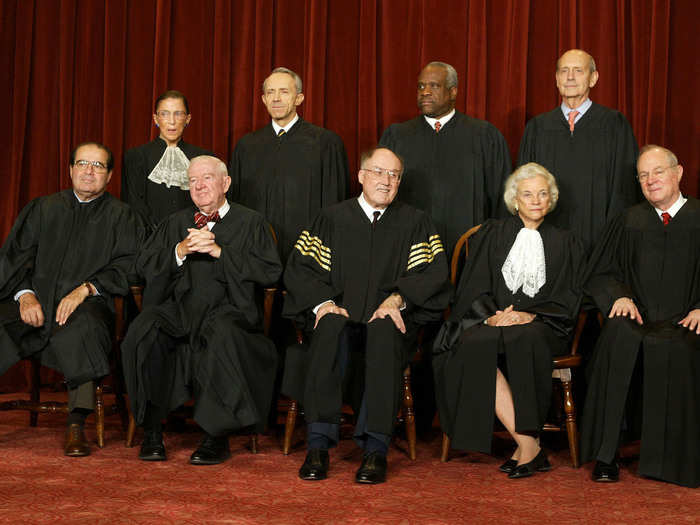
In 2003, the justices decided to take a new photo because they had served together nine years without any changes to the court. A photo from that session is seen above.
Source: The New York Times

Last year, that changed slightly thanks to advances in digital photography.
For the 2017 photo, as seen above, each justice was able to choose which photo they looked best in, and each of those shots was edited into the final photo.
In reality, the shot is actually a composite, instead of a photo, but it's impossible to tell.
Source: The New York Times

After a Supreme Court photographer takes the official picture, news photographers are let into the east conference room to take photos as well.
For decades, news photographers were given just 3 minutes to take their pictures. Chief Justice William H. Rehnquist thought this was too long and cut the time down to 2 minutes.
During November's photo, the Supreme Court's public information officer used a stopwatch to count off the 120 seconds that photographers were allowed to take their pictures.
You can hear her calling the time in this video »
Source: The New York Times

"Our nemesis is Thomas, because he’ll start laughing and joking with whoever is next to him," Dennis Brack, who photographed the justices for many years for Black Star Publishing Company, told The Times.
"If you’re doing a group picture, you want everyone looking at you and looking serious."
Source: The New York Times

"Our biggest non-fan was Thurgood Marshall," Brack said. "His solution was to go to sleep."
Source: The New York Times

While McReynolds' anti-Semitism is well documented, the story is false.
According to a 2015 essay by Franz Jantzen, one of the court's photographers, it was all a misunderstanding based on a letter that McReynolds sent to then-Chief Justice William Howard Taft.
McReynolds said he didn't want to "go through the bore of picture taking until there is a change in the court." He doesn't mention Brandeis at all.
And in fact, Jantzen says McReynolds "showed up for all 10 sittings during his tenure when the new group photograph was to be taken."
"At nine of these 10 sittings there was at least one Jewish justice on the court — first Brandeis, then Benjamin Cardozo, and Felix Frankfurter — and although the seating arrangement never called for him to sit beside a Jewish justice, at three of these sessions either Cardozo or Frankfurter stood directly behind him," Jantzen wrote.
Sources: Journal of Supreme Court History, The New York Times
 I quit McKinsey after 1.5 years. I was making over $200k but my mental health was shattered.
I quit McKinsey after 1.5 years. I was making over $200k but my mental health was shattered. Some Tesla factory workers realized they were laid off when security scanned their badges and sent them back on shuttles, sources say
Some Tesla factory workers realized they were laid off when security scanned their badges and sent them back on shuttles, sources say I tutor the children of some of Dubai's richest people. One of them paid me $3,000 to do his homework.
I tutor the children of some of Dubai's richest people. One of them paid me $3,000 to do his homework. Why are so many elite coaches moving to Western countries?
Why are so many elite coaches moving to Western countries?
 Global GDP to face a 19% decline by 2050 due to climate change, study projects
Global GDP to face a 19% decline by 2050 due to climate change, study projects
 5 things to keep in mind before taking a personal loan
5 things to keep in mind before taking a personal loan

Copyright © 2024. Times Internet Limited. All rights reserved.For reprint rights. Times Syndication Service.